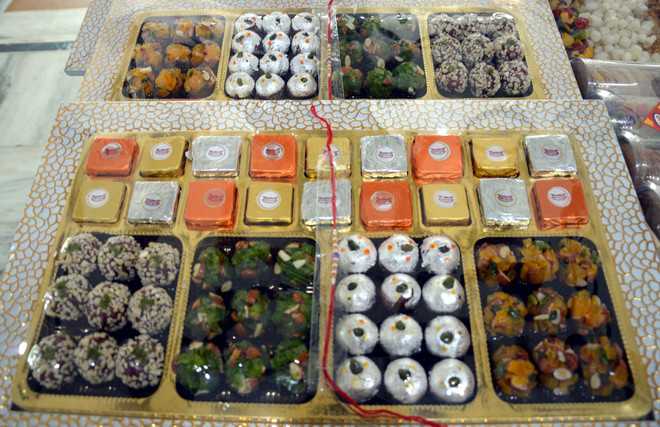Manav Mander
Tribune News Service
Ludhiana, August 5
Same thing, but different Goods and Services Tax (GST) rates is creating confusion among both buyers and sellers. Persons standing at the counter of shops and arguing over the GST rate is a common sight these days.
The people will be buying more goodies and eatables with start of the festival season with Raksha Bandhan. The confusion among shopkeepers and customers is only going to increase in the coming days.
Although the government yesterday clarified that the rate of tax on chocolate-based mithai will be same as mithai, the confusion still prevails in the market. The government also stated that the GST will be levied on the main product and not on ingredients. Still, bewildered shopkeepers are charging tax at different rates on a same product.
As shopkeepers are still not clear about tax on the chocolate-based mithai so they are charging 28 per cent GST on chocolate burfi or rolls.
Some shopkeepers are charging different rates for plain and pista burfi. They are charging the tax applicable on the main ingredients.
There is five per cent tax if one buys plain ‘rasmalai’, but one has to pay 18 per cent tax on buying ‘kesar rasmalai’. Plain burfi is taxed at five per cent. Kaju or pista burfi attract 18 per cent tax because shopkeepers are fixing the GST according to the rate of the dry fruit. Some are even charging 20 per cent GST for silver coated mithai. Rasgulla or gulab jamun if bought over the counter will attract five per cent GST, but if bought in sealed cans then the tax will be 12 per cent.
A shopkeeper at the Civil Lines said, “There is a lot of confusion in the market. Traders are still not clear about the rate of the GST to be charged.”
“I am now aware that the GST on chocolate mithai has been reduced to five per cent, but we are still charging 28 per cent. I will have to ask my CA because our software shows 28 per cent tax,” he said.
Meanwhile, the GST on snacks such as namkeen, kachori, samosa is 12 per cent. “Samosa, which was earlier available for Rs 10, now sells at Rs 12. Samosa is the snack, which we relish. Now, it has also been taxed. I wonder why the government is taxing eatables,” said Ram Naresh, a migrant.
Twelve per cent tax has been levied on samosa, kachori, pakoda, chaat, golgappa, dhokla, which were exempt from the GST earlier. What adds to the confusion is the 18 per cent GST on samosa or chaat if it is served in a restaurant. Now, whether to buy sweets from a local shop or savour these while sitting in an air-conditioned restaurant is a personal choice.
What an expert says
A city-based chartered accountant Ramesh Verma said, “The GST on chocolates will be 28 per cent while on chocolate mithai it will be five per cent. Besides, the GST will be charged on a product as a whole and not according to ingredients. So, be it Pista burfi or Kesar rasmalai, the rate of the GST will be five per cent. There is no higher rate of tax for silver coated mithai. Snacks and namkeen are charged 12 per cent GST, but the tax rate changes if these are served in a restaurant. Rasgulla and gulab jamun are taxed at five per cent. The tax increases to 12 per cent if these are sold in packed sealed cans. The rate of packed goods with preservatives is then applicable on such products.
Unlock Exclusive Insights with The Tribune Premium
Take your experience further with Premium access.
Thought-provoking Opinions, Expert Analysis, In-depth Insights and other Member Only Benefits
Already a Member? Sign In Now










